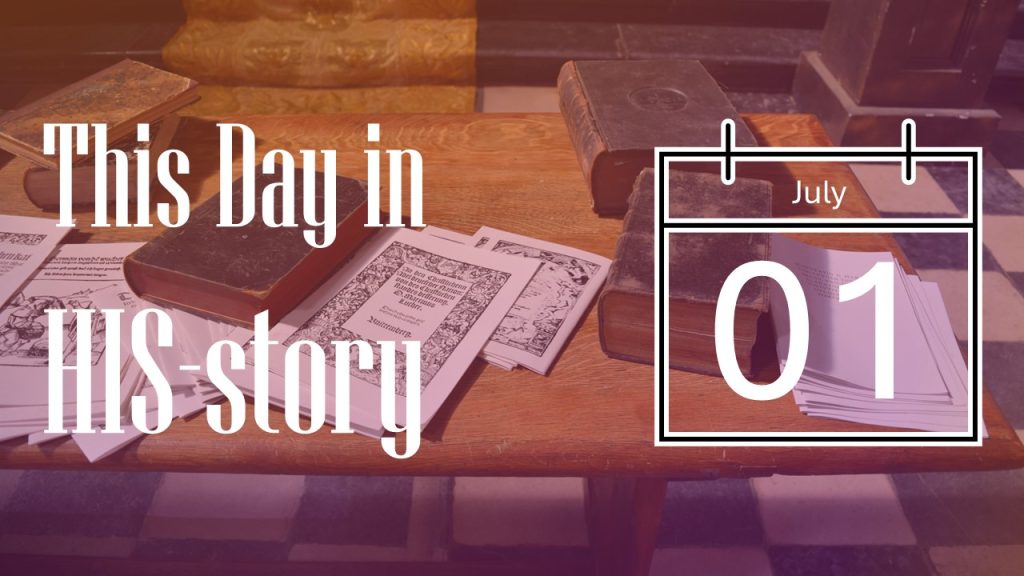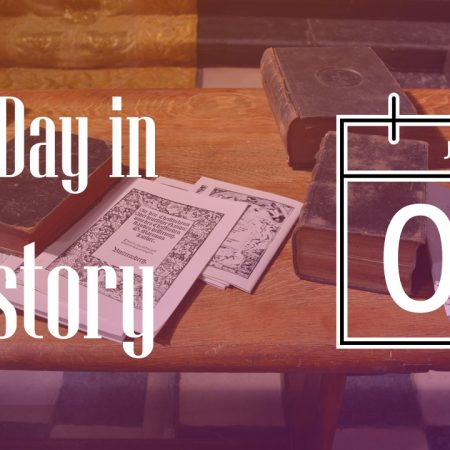
1555
The sheriff feared a riot if he moved John Bradford while most people were still out in the streets. And so he had his soldiers transfer the condemned man to Newgate Prison around midnight. Despite the government’s attempt at secrecy and the late hour, thousands of the good man’s supporters lined the way. There was no riot.
A rumor sped through the streets that John would be burned to death at 4 a.m. the next morning. Indignant crowds gathered before the crack of dawn, filling the streets around Smithfield, the place of execution. Among them were Catholics, outraged because the charges against the Protestant preacher were so obviously trumped up.

When Mary, the Catholic queen, had ascended the English throne after the death of Protestant Edward VI, she immediately took steps to restore the Roman Church. Some of the Catholic preachers were not well received. One named Bourne had a dagger hurled at him when he spoke. Terrified, Bourne asked John to calm the crowd. John did so and shielded Bourne with his own body. After rebuking the mob, John Bradford and John Rogers led the trembling Bourne to safety.
“You save him that will help to burn you!” warned one of Bourne’s enemies. And that is what happened. Three days later the crown accused John Bradford, the man who had helped calm the situation and who had saved Bourne’s life, with trying to stir up the mob! John was imprisoned in the tower of London.
In the tower, the tender-hearted preacher studied his Bible daily and preached often to the other prisoners. He shared his money with them. When he saw thieves and murderers taken to the gallows, he would say, “But for the grace of God, there goes John Bradford.” He was so trusted by the jailor that the man actually let him out twice to tend to religious needs, simply on the strength of his word. John always hurried back before the promised time.
In prison, John wrote constantly–letters and sermons. The Earl of Derby complained “that he has done more hurt [to Mary’s cause] by letters, and by exhorting those that have come to him in religion, than ever he did, when he was abroad, by preaching.”
With soldiers lining the way on this day, July 1, 1555, John was led to his death. He asked permission to give his clothes to his poor servant. It was all he had left. That done, he was bound to one side of the stake and another Protestant witness, John Lease on the other side. John Bradford turned to his partner and said “Be of good comfort brother; for we shall have a merry supper with the Lord this night!” He prayed to be worthy of the Lord in death and quoted Christ’s words, “Strait is the way, and narrow is the gate that leads to eternal salvation, and few there be that find it.” Soon afterward, he was in eternity. Evangelical churchman J. C. Ryle ranked Bradford’s writings up with those of the great Anglican theologians Latimer, Hooper and Jewel.
1737
HT: Christian History Institute
In 1727 Jonathan Edwards became assistant pastor of Northampton’s congregational church and two years later its sole minister. He occupied that position for twenty years, during which he presided over an intense revival, and wrote a number of books defending the revival and explaining God’s sovereignty. Over time his preaching fell out of favor, in part because of his opposition to what was called the Halfway Covenant. Under original Puritan rules, a person could become a church member only after declaring a conversion experience. Only full members could have their children baptized. The Half-Way Covenant allowed the baptism of children whose parents had not made a claim to conversion. Eventually relations between Edwards and his congregation became so strained he was voted out of the pulpit.

On this day 7 July, 1750, he gave his farewell sermon.
“It often comes to pass in this evil world, that great differences and controversies arise between ministers and the people under their pastoral care. Though they are under the greatest obligations to live in peace, above persons in almost any relation whatever, and although contests and dissensions between persons so related are the most unhappy and terrible in their consequences on many accounts of any sort of contentions, yet how frequent have such contentions been!”
1932
“A million a month pass into Christless graves over there [China],” wrote John Stam to his brother. The need of the Chinese people for Christ gnawed at him. God would use him if he was broken and obedient to the Lord’s will, he said. He studied at Moody Bible Institute and prepared himself for mission work. Determined to learn practical faith, he relied wholly on the Lord for his needs, convinced that ” my God shall supply all your need according to his riches in glory by Christ Jesus.” Every weekend he traveled 200 miles to minister in a small church and trudged the streets, reaching out to the lost. Back in Chicago, he attended a weekly China prayer meeting, preparing to offer himself to work in the toughest areas of that great, ancient land.
At the China prayer meeting he met Betty Scott. She, too, was preparing for China. They fell in love. Painfully they recognized that marriage was not yet possible. “The China Inland Mission has appealed for men, single men, to itinerant in sections where it would be impossible to take a woman until more settled work has commenced,” wrote John. He committed the matter to the Lord, whose work, he felt, must come before any human affection. Betty would be leaving for China before him. As a matter of fact, he had not yet even been accepted by the China Inland Mission whereas she had. They parted after a long, tender day, sharing their faith, picnicking, talking, praying.

John continued his studies. That summer he went to a Philadelphia home of the China Inland Mission. After six weeks, on this day, July 1, 1932, he was accepted for service in China. Now he could at least head toward the same continent as Betty. Soon he was on his way, turning down a luxury cruise which was offered him, and crossing the ocean third class on the Empress of Japan. With so many missionaries suffering privation he did not feel it appropriate to indulge in such luxury.
Betty meantime found her ministry blocked in China. A senior missionary had been captured by the Communists in the region where she was to work. The mission directors decided to keep her in Shanghai. Mission decisions also brought John to Shanghai. Thus the Lord put them back together years before they expected it. They became engaged and soon married. In 1934 a daughter was born to them.
Shortly after Helen Priscilla Stam was born, the Stams were captured by Communist bandits. The Communists discussed aloud whether to kill the baby and rid themselves of the nuisance. An old farmer pleaded for her life. “It’s your life for hers, then,” said the Communists, and killed him on the spot. A few days later, John and Betty Stam and loyal Chinese Christians were beheaded. John died, an expression of joy on his face. Moments before, he had pleaded with his captors to spare the life of a Chinese Christian. Betty quivered once and accepted her fate. Pastor and Mrs. Lo brought their daughter, Helen Priscilla Stam, to safety.
